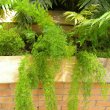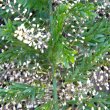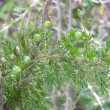| Botanical Name |
Asparagus densiflorus - Sprengeri |
| Family |
Asparagaceae - The asparagus family. |
| Pronunciation |
a-SPARE-uh-gus den-see-FLOR-us - SPRENG-er-ee |
| Common Name(s) |
English: Asparagus fern; Emerald fern; Basket asparagus
IsiZulu: Isiqobola; Umgcagcazane; Uvelabahleke
|
| Plant Group |
- Perennial A plant whose life cycle lasts for three or more seasons.
|
| Plant Size |
- Medium to Large
| Tree | 15m to 20m |
| Shrub | 2m to 3m |
| Perennial/ground cover | 60cm to 75cm |
| Bulb | 60cm to 1m |
| Succulent | 60cm to 1m |
|
| Position |
- Canopy Shade Canopy shade is found below closely grown trees where some light filters through. Ideal for the protection of herbaceous plants.
- Dry Shade Shady areas where soil has poor water retention or are dependent on rain for their moisture needs.
- Light or Dappled Shade Found below trees with sparse, open foliage. Ideal for the protection of herbaceous plants.
- Partial Shade The area is in shade for part of the day and in full sun for part of the day.
- Sun The area is in full sun for all or most of the day, all year round.
|
| General Information |
- Attractive fruits, berries or seeds Brightly coloured fruits or berries increase and extend the visual impact of the plant and are especially attractive to birds and other small wildlife.
- Drought Tolerance: Moderate The plant is moderately adapted to arid conditions and can survive short periods of drought and high temperatures without extra water.
- Evergreen Plants that have leaves all year round.
- Fragrant / Aromatic These plants posses a strong, usually pleasant odour.
- Frost: Half-hardy The plant is able to survive low temperatures and some frost but requires protection against severe frost.
- Salt spray tolerant A plant with specific adaptations enabling it to grow in a saline environment.
- Sand tolerant Plants adapted to survive in nutrient poor, very sandy soils.
- Thorns / Spines / Prickles Thorn: A hard, woody, pointed branchlet.
Spine: A modified leaf forming a hard, sharp-pointed outgrowth.
Prickle: A small, sharp-pointed outgrowth growing from the bark of the plant.
- Water Moderate These plants will need some extra watering compared to water-wise plants. Plant them together, in at least some shade and in a convenient proximity to the house so that grey water can be utilised during times of drought.
|
| Specific Information |
Asparagus densiflorus is a delicate, fern like perennial plant with arching stems up to 1 m long and a scrambling habit. The plant forms a large cushion of dark green needle-like leaves. It is most useful as a ground cover in partial or light shade but will grow in full sun if watered regularly. Unlike most asparagus fern species, it has only very small, hardly noticeable spines. Although the plant appears fernlike, the flowers and fruit place it clearly among the angiosperms. The plants have extensive root systems with numerous grape sized tubers, which are used in nature to provide food during long periods of drought in summer. The root system is particularly useful for binding soil on slopes.
The plants flower briefly for about two weeks, usually every three years and are followed by bright red berries.
It is also attractive as an indoor or patio plant in large containers or hanging baskets.
|
| Ad Break |
|
| Flowers |
| Description |
very small, half hidden by the foliage |
| Season |
- Summer Plants will seldom bloom for the entire season as given in the list, but should flower during a period within these parameters.
|
| Colour |
|
| Growth Rate |
- Moderate to Fast Specifying growth rate can be very misleading as there is considerable variation of growth rate depending on type and species of plant, available water, supplementary feeding, mulching and general care, as well as the plants suitability and adaptability to the garden environment.
|
| Plant Uses |
- Attracts bees, butterflies or other insects This plant attracts insects which can be food for birds or other creatures in your garden.
- Attracts Birds This plant will attract birds.
- Border A strip of ground, at the edge of a driveway or path in which ornamental plants or shrubs are planted.
- Container Trees, shrubs and ornamental species that can adapt to growing in a restricted environment.
- Filler Either a fast growing tree or shrub used temporarily to fill in an area while the permanent plants grow to a desired size, or a plant used to fill gaps in borders or beds.
- Foliage Plant Plants grown because their foliage is colorful or unique. Many of these plants have insignificant flowers.
- Ground Cover Low-lying plants that spread fast, require minimal maintenance, and cover large expanses or bare areas between bulbs or shrubs. They provide protection from erosion and drought and improve the visual appearance of the garden.
- Pot Plant A plant that needs a protected environment on a patio or indoors.
- Stabilize Banks Plant is used to prevent soil erosion because their roots will form a mat that stabilizes the soil and keeps it from washing away in heavy rains.
- Suitable for coastal gardens Plants adapted to dry, sandy soil, forceful wind, limited rainfall and intense sunlight.
- Suitable for seaside gardens Plants that will survive the hostile environment of harsh salty winds, dry sandy soil, irregular rainfall and heat found in seaside gardens.
- Water Features These plants may have dramatic, lush foliage or graceful form. They do not shed excessive leaves and do not have invasive root systems.
- Wild Garden An indigenous garden planted for the benefit of wildlife and birds. Provides food, water, a variety of mini-biomes and no poisonous chemicals are used.
|
| Distribution and Habitat |
coastal areas in the south and eastern Cape and KwaZulu-Natal, on coastal dunes, open rocky places, forests and bushy areas
|
| Planting Suggestions |
Asparagus densiflorus grows in most soils but does much better in soil which is rich in organic matter and is watered regularly. A thick mulch of compost can be spread around the plants to retain moisture and keep the soil cool. When grown in deep shade they tend to become rather lax with fewer leaves. In full sun, the plants become much more sturdy and dense. After flowering or if the plant loses its attractive shape, cut the stems back close to the soil level. They are easily propagated by separating the tubers into fairly large clumps. Water well after transplanting and keep moist until the plants show signs of growth. Seed can be sown in spring or early summer. The seed should be removed from the fleshy berries, placed in a suitable planting medium and kept moist.
|
| Medicinal Uses |
Although many of the Asparagus fern species are used in traditional medicine, I have found no data indicating that Asparagus densiflorus is used in this way.
|
| Ad Break |
|










Discuss this plant
Share knowledge, ask a question or give an experience.